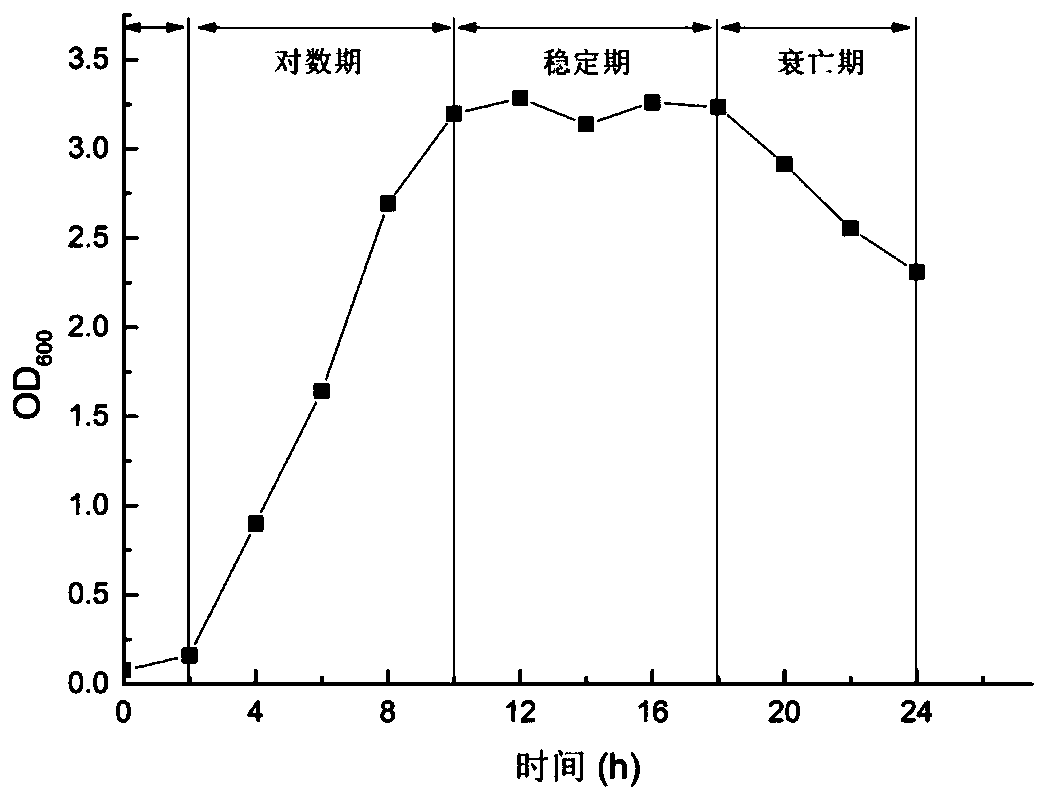A strain of Bacillus amyloliquefaciens and its application in degrading feathers to produce oligopeptides
A technology for dissolving amyloid spores and bacilli, which is applied in the field of microorganisms, can solve the problems of industrial production, difficulty in full utilization and rapid consumption, and high content of macromolecular protein, which are unfavorable for the regeneration and utilization of livestock and poultry waste, and achieve full recycling and low feather weight. The effect of high peptide content and optimal feed efficiency
- Summary
- Abstract
- Description
- Claims
- Application Information
AI Technical Summary
Problems solved by technology
Method used
Image
Examples
Embodiment 1
[0030] Embodiment 1: the screening of bacterial strain
[0031] 1. Enrichment and acclimatization: Take a mixed sample of soil that has accumulated feathers for a long time, fermentation pond residue and sewer sludge, and mix it with water at a mass ratio of 1:5. Take 10ml of it and put it into a 250ml Erlenmeyer flask filled with 80ml No. 1 enrichment medium, cultivate it on a shaker at 37°C, pH value 7, and 150r / min until the feathers are basically rotted; then take the enrichment medium in the bottle The liquid was inoculated into No. 2 enrichment medium at an inoculum amount of 5%, cultivated under the same conditions as above until the feathers were basically rotted, and passed twice.
[0032] The composition of the No. 1 enrichment medium is: NH 4 Cl 0.5g, NaCl 0.5g, K 2 HPO 4 0.7g, KH 2 PO 4 0.35g, MgSO 4 ·7H 2 O 0.2g, yeast extract 0.1g, glucose 1g, pH value 7.0, add feather 5g, sterilize at 115°C for 30min.
[0033] The composition of the No. 2 enrichment med...
Embodiment 2
[0040] Embodiment 2: bacterial strain identification
[0041] 1. Observation of bacterial colony and bacterial morphology: The purified and isolated Bacillus amyloliquefaciens H5 was cultured by streaking on the beef extract peptone plate medium, and cultured at a constant temperature of 37°C for 48 hours. The colonies were observed to be nearly round, flat, and centered by naked eyes. Raised, with nicks on the edges, opaque, sticky and hard to pick. Observed under a scanning electron microscope, as figure 1 As shown, the bacterium was rod-shaped, 1.12-2.34 μm long, without flagella, and the Gram test was positive (such as figure 2 shown).
[0042] 2. Observation of culture characteristics: Bacillus amyloliquefaciens H5 was inoculated in beef extract peptone medium with the same inoculum amount, cultured on a shaking table at different temperatures for 18 hours, and the strains in the environment of 15-50°C could grow, and The strain grows fastest in the environment of 28-...
Embodiment 3
[0045] Example 3: Optimization of fermentation conditions for producing oligopeptides
[0046] 1) Preparation of secondary seed liquid: Pick a ring of Bacillus amyloliquefaciens H5 preserved on a slant, inoculate it into beef extract peptone test tube culture medium at 28-40°C for 12 hours to obtain primary seed liquid, and then inoculate the primary seed liquid according to Inoculate 2% of the inoculum into 30ml beef extract peptone medium and incubate at 28-40°C for 12h to obtain the secondary seed solution.
[0047] The beef extract peptone medium comprises: peptone 10g / L, beef extract 5g / L, sodium chloride 5g / L, pH value 6.0-8.0, sterilized at 121°C for 20min.
[0048] 2), fermentation and degradation of feathers: the secondary seed liquid of Bacillus amyloliquefaciens H5 was inserted into the fermentation medium at an inoculum size of 2%, and a single factor experiment was used to investigate the degradation rate of feathers by different fermentation pH, fermentation temp...
PUM
 Login to view more
Login to view more Abstract
Description
Claims
Application Information
 Login to view more
Login to view more - R&D Engineer
- R&D Manager
- IP Professional
- Industry Leading Data Capabilities
- Powerful AI technology
- Patent DNA Extraction
Browse by: Latest US Patents, China's latest patents, Technical Efficacy Thesaurus, Application Domain, Technology Topic.
© 2024 PatSnap. All rights reserved.Legal|Privacy policy|Modern Slavery Act Transparency Statement|Sitemap



